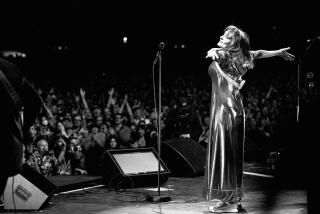Iggy Pop Reaches Back to ‘Raw Power’
- Share via
This 1973 album runs only 34 minutes, but it stands as one of the pivotal works in rock--an album that links the brute force of the Who with the coming anarchy of the Sex Pistols and the raw self-affirmation of early grunge.
“Raw Power” was far too radical for the corporate-rock sensibilities of radio when it was first released by Columbia Records, so it only spent three weeks on the Top 200 sales chart, peaking at No. 183.
Iggy Pop, whose real name is James Osterberg--was even more revolutionary on stage than on record. In concert, Pop, who is now 50, went to sometimes frightening extremes to arouse audiences and himself. He not only typically dove head-first into the crowd, but also sometimes cut himself with broken glass.
His albums with the Stooges also attacked contemporary standards in ways that made them looked upon with suspicion by everyone from the record companies to radio programmers.
While his songwriting tended toward rock tradition (traces of the Who in “Search and Destroy,” Doors touches in “Gimme Danger”), the recordings bordered on sonic chaos.
Dropped by Elektra Records, the home of the Doors, after two albums, the Stooges--which also included guitarist James Williamson, drummer Scott Asheton and bassist Ron Asheton--were pretty much in limbo until David Bowie, who was at the center of rock attention at the time, helped resurrect Iggy’s career.
According to Pop’s comments in the excellent liner notes, he and the Stooges recorded “Raw Power” in London. The record company didn’t like the sound of the album, he says, so Bowie volunteered to step in and remix the collection. While Columbia released the new version, the Bowie mix was not well received by Stooges fans over the years.
“People kept asking me--musicians, kids I would see--’Have you ever thought about remixing it?’ I’d get complaints. And it got much worse when [the album] went to CD. . . . It sounded awful compared to the [vinyl] record. There’d always been a question in my mind, when I heard it, there’s no bottom, there’s no power. . . .”
Pop decided to remix the album recently after some members of Henry Rollins’ band found tapes that had been made from the original Sony masters. While the album now sounds more compatible with certain rock radio formats, it’s only because the formats have become more adventurous over the years. Rather than weaken the sound, the new version simply presents greater instrumental clarity and definition.
As a liner note bonus, Pop discusses each of the album’s eight songs. Though many anxious parents no doubt worried about the implications of the closing tune, “Death Trip,” Pop explains it was a reflection on the band’s dim future.
“The reason it’s last on the album is that I’m singing about what I realize is happening here,” he says, recalling the making of the album in 1973. “I know this album’s doomed. . . . I know that nobody’s gonna promote it. I know it’s not going to be on the radio, there’s a lot of people who aren’t gonna like it. But on the other hand, I’m totally convinced this is the best music so that’s what I’m gonna do, that’s what I’m singing about.”
It may have taken all these years to get the album right, but it has finally arrived.
Albums are rated on a scale of one star (poor), two stars (fair), three stars (good) and four stars (excellent).
More to Read
The biggest entertainment stories
Get our big stories about Hollywood, film, television, music, arts, culture and more right in your inbox as soon as they publish.
You may occasionally receive promotional content from the Los Angeles Times.









